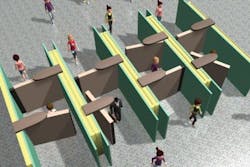The shooting massacre last month at Sandy Hook Elementary School in Newtown, Conn. has spurred vigorous debate about what security measures need to be taken to improve security at schools across the nation. Most of the attention has focused on new gun control legislation and placing armed guards in schools.
However, a Washington-based company has developed a solution that could potentially stop a mass shooting before it starts. Barbecan Security Systems recently announced that it has received a patent for what it calls a robotic Linear Revolving Door (LRD) security portal.
Bob Osann, the company’s managing director, said that he first came up with the idea for this technology following the shooting on the campus of Virginia Tech in 2007. Osann works mainly as a consultant in the high-tech industry and has founded five Silicon Valley companies during his career.
"I just had a real hard time with the fact that someone could walk into a building at a school and kill 32 people and I felt there must be a way to prevent this," said Osann. "The problem is that you had to have a high security portal, like a mantrap, but they’re slow. You have a passage way with a door at each end and you have to completely clear the portal before the person can enter and it’s a slow process. It would not work for high-traffic entrances like a school or many other buildings and situations that require a lot more people to be coming and going."
Eventually, Osann said he was able to come up with an "unusual configuration" for a portal that would allow people to keep moving at their own pace while at the same time preventing anyone with a firearm from entering a site.
"By having the door panels open in this weave pattern… you can keep things moving. But there is a moment when both door panels are parallel and the person’s inside and that’s when you would make your final detection," he explained. "If you detect a weapon, you stop the portal and there would be a display that tells the person to reverse and exit the portal in the direction they came. "It’s fully robotic. It will be a very sophisticated system when we bring it to reality."
Now that they have received a patent, Osann said the next step will be either to obtain funding or partner with a company to build a prototype of the solution and begin the testing process. Osann believes the best approach would be to partner with an existing company that’s interested in bringing the LRD portal to fruition. "My feeling at the moment is that the best way to do this is to partner," he said. "I think it would move the whole process along quicker and bring it to market faster. We really want to see this out there doing what it’s intended to do and preventing some of these events from happening."
Osann said that the company has been approached by a few, smaller security firms and that they’ve also received interest from two, "major" government labs. In addition to schools, the company said the portal could also be used in other high throughput environments such as shopping malls, theaters, banks, stadiums, airports, office buildings, and government facilities.
"The timing of our notice of allowance on the first patent happened to come almost exactly at the time as the Sandy Hook shooting," Osann said. "That’s why we did the announcement. It just seemed like the time has come to do something and move ahead."



